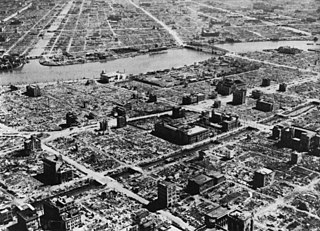
Strategic bombing is a systematically organized and executed attack from the air which can utilize strategic bombers, long- or medium-range missiles, or nuclear-armed fighter-bomber aircraft to attack targets deemed vital to the enemy's war-making capability. It is a military strategy used in total war with the goal of defeating the enemy by destroying its morale, its economic ability to produce and transport materiel to the theatres of military operations, or both. The term terror bombing is used to describe the strategic bombing of civilian targets without military value, in the hope of damaging an enemy's morale.

Carpet bombing, also known as saturation bombing, is a large area bombardment done in a progressive manner to inflict damage in every part of a selected area of land. The phrase evokes the image of explosions completely covering an area, in the same way that a carpet covers a floor. Carpet bombing is usually achieved by dropping many unguided bombs.
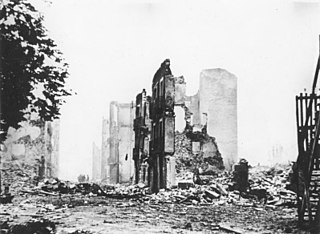
The aerial bombing of cities is an optional element of strategic bombing, which became widespread in warfare during World War I. The bombing of cities grew to a vast scale in World War II and is still practiced today. The development of aerial bombardment marked an increased capacity of armed forces to deliver ordnance from the air against combatants, military bases, and factories, with a greatly reduced risk to its ground forces. The killing of civilians and non-combatants in bombed cities has variously been a deliberate goal of strategic bombing, or unavoidable collateral damage resulting from intent and technology. A number of multilateral efforts have been made to restrict the use of aerial bombardment so as to protect non-combatants and other civilians.
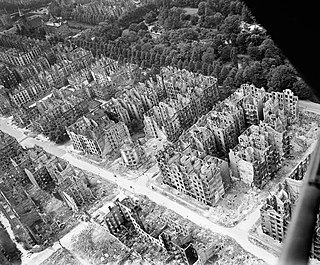
The Allied bombing of Hamburg during World War II included numerous attacks on civilians and civic infrastructure. As a large city and industrial centre, Hamburg's shipyards, U-boat pens, and the Hamburg-Harburg area oil refineries were attacked throughout the war.

The Eighth Air Force (Air Forces Strategic) is a numbered air force (NAF) of the United States Air Force's Air Force Global Strike Command (AFGSC). It is headquartered at Barksdale Air Force Base, Louisiana. The command serves as Air Forces Strategic – Global Strike, one of the air components of United States Strategic Command (USSTRATCOM). The Eighth Air Force includes the heart of America's heavy bomber force: the Northrop Grumman B-2 Spirit stealth bomber, the Rockwell B-1 Lancer supersonic bomber, and the Boeing B-52 Stratofortress heavy bomber aircraft.
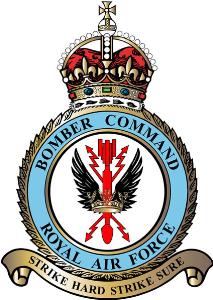
RAF Bomber Command controlled the Royal Air Force's bomber forces from 1936 to 1968. Along with the United States Army Air Forces, it played the central role in the strategic bombing of Germany in World War II. From 1942 onward, the British bombing campaign against Germany became less restrictive and increasingly targeted industrial sites and the civilian manpower base essential for German war production. In total 364,514 operational sorties were flown, 1,030,500 tons of bombs were dropped and 8,325 aircraft lost in action. Bomber Command crews also suffered a high casualty rate: 55,573 were killed out of a total of 125,000 aircrew, a 44.4% death rate. A further 8,403 men were wounded in action, and 9,838 became prisoners of war.

World War II (1939–1945) involved sustained strategic bombing of railways, harbours, cities, workers' and civilian housing, and industrial districts in enemy territory. Strategic bombing as a military strategy is distinct both from close air support of ground forces and from tactical air power. During World War II, many military strategists of air power believed that air forces could win major victories by attacking industrial and political infrastructure, rather than purely military targets. Strategic bombing often involved bombing areas inhabited by civilians, and some campaigns were deliberately designed to target civilian populations in order to terrorize them and disrupt their usual activities. International law at the outset of World War II did not specifically forbid the aerial bombardment of cities – despite the prior occurrence of such bombing during World War I (1914–1918), the Spanish Civil War (1936–1939), and the Second Sino-Japanese War (1937–1945).

The second Schweinfurt raid, also called Black Thursday, was a World War II air battle that took place on 14 October 1943, over Nazi Germany between forces of the United States 8th Air Force and German Luftwaffe fighter arm (Jagdwaffe). The American bombers conducted a strategic bombing raid on ball bearing factories to reduce production of these vital parts for all manner of war machines. This was the second attack on the factories at Schweinfurt. American wartime intelligence claimed the first Schweinfurt–Regensburg mission in August had reduced bearing production by 34 percent but had cost many bombers. A planned follow-up raid had to be postponed to rebuild American forces.

The South-East Asian Theatre of World War II consisted of the campaigns of the Pacific War in the Philippines, Thailand, Indonesia, Indochina, Burma, India, Malaya and Singapore between 1941 and 1945.
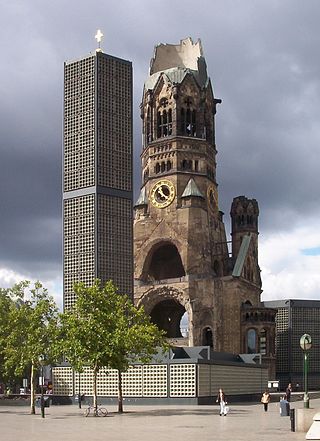
Berlin, the capital of Nazi Germany, was subject to 363 air raids during the Second World War. It was bombed by the RAF Bomber Command between 1940 and 1945, the United States Army Air Forces' Eighth Air Force between 1943 and 1945, and the French Air Force in 1940 and between 1944 and 1945 as part of the Allied campaign of strategic bombing of Germany. It was also attacked by aircraft of the Red Air Force in 1941 and particularly in 1945, as Soviet forces closed on the city. British bombers dropped 45,517 tons of bombs, while American aircraft dropped 22,090.3 tons. As the bombings continued, more and more people fled the city. By May 1945, 1.7 million people had fled.
Big Week or Operation Argument was a sequence of raids by the United States Army Air Forces and RAF Bomber Command from 20 to 25 February 1944, as part of the European strategic bombing campaign against Nazi Germany. The planners intended to attack the German aircraft industry to lure the Luftwaffe into a decisive battle where the Luftwaffe could be damaged so badly that the Allies would achieve air superiority which would ensure success of the invasion of continental Europe later in 1944.

The Bulgarian capital of Sofia suffered a series of Allied bombing raids during World War II, from mid 1941 to early 1944. Bulgaria declared war on the United Kingdom and the United States on 13 December 1941. The Southern Italy-based Allied air forces extended the range of their strategic operations to include Bulgaria and other Axis allies in 1943.

Operation Hurricane was a 24-hour bombing operation to "demonstrate to the enemy in Germany generally the overwhelming superiority of the Allied Air Forces in this theatre" and "cause mass panic and disorginazation [sic] in the Ruhr, disrupt frontline communications and demonstrate the futility of resistance".

Royal Air Force North Pickenham or more simply RAF North Pickenham is a former Royal Air Force station located 3 miles (4.8 km) East of Swaffham, Norfolk, England.

During World War II, the city of Lübeck was the first German city to be attacked in substantial numbers by the Royal Air Force. The attack on the night of 28 March 1942 created a firestorm that caused severe damage to the historic centre, with bombs destroying three of the main churches and large parts of the built-up area. It led to the retaliatory "Baedeker" raids on historic British cities.
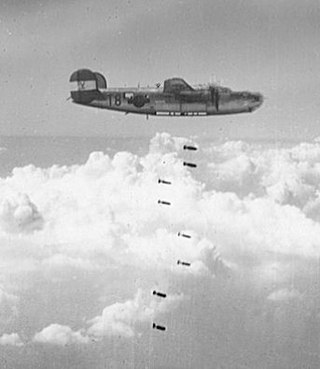
The 491st Bombardment Group is a former United States Army Air Forces unit. It was activated in October 1943 as a heavy bomber unit, drawing its cadre from the former 17th Antisubmarine Squadron. After training in the United States, the group deployed to the European Theater of Operations, where it participated in the strategic bombing campaign against Germany, earning a Distinguished Unit Citation in an attack against Misburg. The group flew 187 combat missions. Following V-E Day, the group returned to the United States and was inactivated at McChord Field, Washington in September 1945.

The Bombing of Bremen in World War II by the British Royal Air Force (RAF) and US Eighth Air Force involved both indiscriminate "area bombing" and, as capacity improved, more targeted raids upon the city's military-industrial facilities. These included the shipyards of Vulkan, AG Weser and Atlas Werke, the Valentin submarine pens, oil refineries and the aircraft works of Focke-Wulf.

The bombing of Nijmegen on 22 February 1944 was a target-of-opportunity aerial bombing raid by the United States Army Air Forces on the city of Nijmegen in the Netherlands, then occupied by Nazi Germany. In terms of the number of victims, it was one of the largest bombardments of a Dutch city during World War II. Officially, nearly 800 people were killed by accident due to inaccurate bombing, but because people in hiding were not counted, the actual death toll was likely higher. A large part of the historic city centre was destroyed, including Saint Steven's Church. Saint Augustine's Church and Nijmegen railway station were heavily damaged as well.
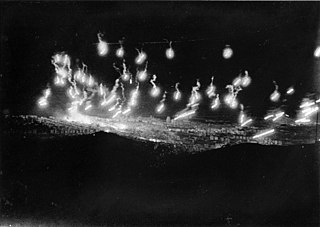
Owing to the importance of its port and industries, the Italian port city of Genoa, the regional capital and largest city of Liguria, was heavily bombarded by both Allied air and naval forces during Second World War, suffering heavy damage.


















